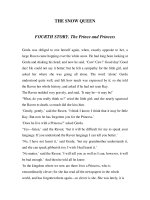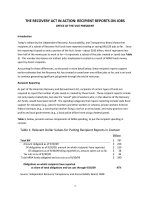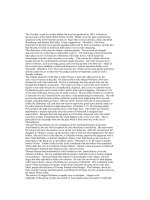the crucible act four
Bạn đang xem bản rút gọn của tài liệu. Xem và tải ngay bản đầy đủ của tài liệu tại đây (31.53 KB, 1 trang )
'The Crucible- Act Four'
The scene in Act Four of The Crucible, by Arthur Miller, defines the
characterization, themes, and conflicts of the play. The scene takes place in a
court dungeon where John Proctor, is confronted by his wife Elizabeth for the
first time in many months. The couple is imprisoned on having been falsely
convicted of practicing witchcraft. While Elizabeth has been held with the
rest of the members of the community, John has been isolated in a dark,
dingy, dungeon. He is to be hung for his 'crimes' the very next morning. The
court officials send Elizabeth in to convince John to confess in writing that
the accusations against him are true and that the verdict is just.
The conversation that takes place between Proctor and Elizabeth is
'above sorrow, beyond it.' They are bewildered by the hatred against them.
They know they have done nothing, and are falsely accused. Yet, even with
the glum atmosphere created by the conversation, the reader detects a
glimmer of optimism, determination, and hope in Proctor's voice. The reader
feels that he will fight till the end. 'It is hard to give a lie to dogs.', he says.
Proctor continually wavers in his decision whether to confess to this
outright lie, or to spite the evil and be hung in martyrdom. Up to this point in
time, the court officials have no definitive proof that any witchcraft has
actually been practiced. Innocent people are being hung only on account of
the testimony given by one young girl. Proctor realizes that by confessing, he
will mar the memory of the many who have thus far been killed without
confirming the false accusations. These dead would not sign their names
falsely just to spare their own life. How could Proctor disrespect the cause
that these dead gave their lives for, just to spare himself?
Throughout the scene, Elizabeth struggles to let John be the one to
decide whether he should spite the court or save his own life. She never
provides a definite answer and seems to be in turmoil. Elizabeth states, 'I
want you living, John. That's sure.' Yet, when John asks her whether he
should confess so that his life will be saved, she responds,
'Do what you will. But let none be your judge. There be no
higher judge under Heaven than Proctor is! Forgive me, forgive
me, John I never knew such goodness in the world!'
In this scene Elizabeth tells John the story of Giles' death. Giles would
not answer aye or nay to his indictment so that the court would not be
allowed to auction off his property. This allows his sons to inherit his
property upon his death. The court pressed large stones onto his body to
force a confession, yet he would not answer and was killed by the weight of
the stones. This shows that we can not submit to the injustice that can be
brought about in American society. It also portrays that these people who
were wrongly put to death, unselfishly never thought of themselves, only of
others. Giles chose a torturous, painful death rather than a sudden, struggle
free death so that his family could be well.
This scene epitomizes the messages and ideas that Miller tries to
portray in his writing of the play. The conversation between John Proctor and
Elizabeth exhibits the confusion, suffering, despair, determination, and hope
of the victims convicted in this terrible tragedy. Also, the story of Giles
portrays the goodness and selflessness of these martyrs. It is for these reasons
that this scene is the most compelling and instrumental to the plot, themes,
and characters.









